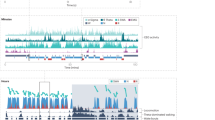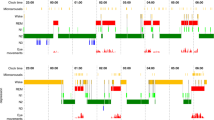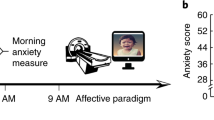Abstract
Among the best characterized neurobiological changes in mood disorders are specific alterations in electroencephalographic (EEG) sleep, including disinhibited rapid eye movement (REM) sleep and suppressed slow wave sleep. A strong link between mood disorders and sleep is that depressive symptoms are alleviated by one night of sleep deprivation and reoccur after sleeping. Sleep underlies homeostatic and circadian mechanisms that interact in complex ways. These relationships have been formalized in electrophysiological, neurochemical and neuroendocrinological models that extend to the pathophysiology of affective illness. Sleep research as a pathophysiological window to the brain has contributed extensively to the understanding of the neurobiology of depression and has been a substantial guide for the advancement of model-driven clinical and preclinical research. Pharmacological probes of normal and depressed sleep play an important role. It is anticipated that the combination of novel topographical EEG and neuroimaging techniques with traditional experimental methods will provide us with further insight into the neurobiology of sleep and depression.
Similar content being viewed by others
Main
Sleep disturbances are among the most prevalent clinical problems and physical signs of depression and are chiefly characterized by increased REM sleep (Benca et al. 1992) and reduced slow wave sleep measures. These changes are not specific for mood disorders, but they may be used for experimental studies probing sleep-regulatory mechanisms as a pathophysiological window to the brain (Gillin and Borbély 1985). The focus of this minireview is on studies examining the relationship between sleep, serotonin (5-HT) and acetylcholine, and their mutual interactions in depression.
ASPECTS OF SLEEP REGULATION
Sleep underlies both homeostatic and circadian factors interacting in complex ways that have been formalized in the 2-process model of sleep regulation (Borbély 1982). Neurochemically, some characteristics of the two processes are associated with interactions between aminergic and cholinergic neurotransmission (for review see Steriade and McCarley 1990) and the regulation of neuropeptides (Ehlers and Kupfer 1987) and other systems. The basic mechanisms unraveled in animals are at least partially paralleled in human studies combining EEG sleep with pharmacological probes. For instance, REM sleep is suppressed following systemic 5-HT1A agonists (Gillin et al. 1994; Seifritz et al. 1996) and promoted following cholinergic agonists (Sitaram et al. 1976; Berger et al. 1985; Gillin et al. 1991b; Seifritz et al. 1998). Muscarinic receptor antagonists, on the other hand, partially suppress REM sleep (Gillin et al. 1991a), and the depletion of central serotonin enhances REM sleep (Bhatti et al. 1998; Moore et al. 1998, 2001; Voderholzer et al. 1998). In depression, it was found that cholinergic REM induction was exaggerated as compared with healthy control subjects (Sitaram et al. 1980; Berger et al. 1989a,b; Gillin et al. 1991b) and suggested cholinergic supersensitivity associated with depression.
Cholinergic activation leads to a suppression of slow wave activity and to an enhancement of higher EEG frequencies during sleep (Berkowitz et al. 1990). This is consistent with the depolarization of thalamocortical cells after stimulation of cholinergic nuclei (Steriade et al. 1991) and corticothalamic 5-HT2 receptors (McCormick and Wang 1991).
ANTIDEPRESSANT ACTION OF SLEEP DEPRIVATION
Probably the most impressive link between mood disorders and sleep regulation is illustrated by the fact that depressive symptoms are acutely alleviated by one night of sleep deprivation and that the initial symptoms reoccur after one night of recovery sleep (Wu and Bunney 1990; Wirz-Justice and Van den Hoofdakker 1999) or even after microsleep episodes (Hemmeter et al. 1998). In terms of the 2-process model, the time-course of depressive symptoms parallels the time-course of delta sleep that is low after sleep and high after wakefulness. This relationship translates into an electrophysiological conception to understanding sleep deprivation's antidepressant properties (Borbély and Wirz-Justice 1982). It has also been postulated that the depressiogenic mechanisms during sleep are somehow related to REM sleep. This view has been supported by the finding that most antidepressants suppress REM sleep, and that suppression (Vogel et al. 1975) or displacement (Berger et al. 1997) of REM sleep relieves depressive symptoms.
The antidepressant effects of sleep deprivation are at least partially associated with modifications of 5-HT system function. In brief, sleep deprivation in laboratory animals enhances the turnover of 5-HT (Asikainen et al. 1995), increases the concentration of 5-hydroxyindoleacetic acid during recovery sleep (Borbély et al. 1980), increases the firing rate of serotonergic neurons in the DRN (Gardner et al. 1997), and downregulates 5-HT1A somatodendritic autoreceptors (Prévot et al. 1996). The selective deprivation of REM sleep augments the behavioral response to serotonergic stimulation (Mogilnicka 1981), decreases the sensitivity of dorsal raphe nuclei (DRN) 5-HT1A autoreceptors (Maudhuit et al. 1996), and modifies the activity of central monoamine oxidases (Thakkar and Mallick 1993). Whereas sleep deprivation modifies some measures of central 5-HT activity (Benedetti et al. 1997; Seifritz et al. 1997a) in healthy humans, the prolactin secretion upon 5-HT stimulation is enhanced after sleep deprivation (Salomon et al. 1994) and may predict clinical response to sleep deprivation (Kasper et al. 1988) in depressed patients. Sleep deprivation's efficacy may be amplified by 5-HT enhancing drugs (Wirz-Justice et al. 1976; Benedetti et al. 1997; Smeraldi et al. 1999) and appears to be related with a functional polymorphism within the promoter of the serotonin transporter gene (Benedetti et al. 1999). Interestingly, tryptophan depletion does not reverse sleep deprivation's antidepressant effects but rather prevents depressive relapse after one night of recovery sleep (Neumeister et al. 1998).
DISCUSSION
Sleep research has provided us with an impressing body of data linking basic neuroscience with pathophysiological concepts of the neurobiology of depression. The translational crosstalk between clinical and preclinical sleep research has stimulated fascinating progress in both fields. Many questions have been solved but many others remained open and warrant further research. For instance, whereas the earlier studies have consistently shown disinhibition of REM sleep in depression (Benca et al. 1992) more recent studies do not necessarily confirm these findings. Furthermore, studies using arecoline (e.g. Gillin et al. 1991b) or RS-86 (e.g. Berger et al. 1989a) as cholinergic probes demonstrated exaggerated REM induction in depressed patients and suggested muscarinic receptor supersensitivity, but studies using pilocarpine could not confirm these findings (Lauriello et al. 1993; Seifritz et al. 1998). It is of note that exaggerated REM induction was only shown in those studies in which the depressed patients had enhanced REM sleep parameters at baseline (Figure 1). A similar situation has been obtained for the 5-HT system: whereas evidence suggests that 5-HT1A agonists such as ipsapirone produce differential neuroendocrine and temperature responses in depressed compared with normal subjects (Maes and Meltzer 1995), ipsapirone did not suppress REM sleep more in depressed patients than in normal control subjects (Gillin et al. 1996). Furthermore, some evidence even suggested opposite relationships and did not show intraindividual correlations between serotonergic REM suppression and cholinergic REM induction in depressed and healthy subjects (Seifritz et al. 1998). In the same vein, the initially reported REM enhancing effects (Moore et al. 1998) of serotonin depletion by means of a tryptophan-free amino acid challenge was not replicated in a second study carried out with virtually the same experimental parameters (Moore et al. 2001).
Effect of systemic cholinergic stimulation on REM latency in depressed patients and normal controls. Gray bars = healthy subjects, black bars = patients with major depression; * = p < .05, ns = not significant. Whereas the cholinergic drugs arecoline (Gillin et al. 1991b, top panel) and RS-86 (Berger et al. 1989b, middle panel) produced an exaggerated REM sleep induction in depressed patients compared with normal controls, the REM latency shortening induced by pilocarpine (Seifritz et al. 1998, bottom panel) was not different between patients and controls (note: in the study with arecoline, the latency from the first to the second REM sleep period was used). Interestingly, baseline REM latency (placebo) was not different in the pilocarpine study. There was also no difference in REM latency effects of the 5-HT1A agonist ipsapirone in normal versus depressed subjects. Data are replotted with authors’ permission.
A fundamental problem of systemic pharmacological probes in human subjects, even with very specific receptor-selective drugs, is that it cannot be directly distinguished whether a drug's action is mediated by pre-, post-, auto-, or heteroceptors, or by a combination of them (e.g. Seifritz et al. 1997b). One promising lead in depression research using sleep regulation as a model of the functional neuroanatomy of depression may in the application of topographic EEG and neuroimaging techniques combined with pharmacological probes.
References
Asikainen M, Deboer T, Porkka-Heiskanen T, Stenberg D, Tobler I . (1995): Sleep deprivation increases brain serotonin turnover in the Djungarian hamster. Neurosci Lett 198: 21–24
Benca RM, Obermayer WH, Thisted RA, Gillin JC . (1992): Sleep and psychiatric disorders: A meta-analysis. Arch Gen Psychiatry 49: 651–668
Benedetti F, Barbini B, Lucca A, Campori E, Colomb C, Smeraldi E . (1997): Sleep deprivation hastens the antidepressant action of fluoxetine. Eur Arch Psychiat Clin Neurosci 247: 100–103
Benedetti F, Serretti A, Colombo C, Campori E, Barbini B, di Bella D, Smeraldi E . (1999): Influence of a functional polymorphism within the promoter of the serotonin transporter gene on the effects of total sleep deprivation in bipolar depression. Am J Psychiatry 156: 1450–1452
Berger M, Höchli D, Zulley J . (1985): Cholinomimetic drug RS86, REM sleep, and depression. Lancet 1: 1385–1386
Berger M, Riemann D, Hochli D, Spiegel R . (1989a): The cholinergic rapid eye movement sleep induction test with RS-86. State or trait marker of depression? Arch Gen Psychiatry 46: 421–428
Berger M, Riemann D, Höchli D, Spiegel R . (1989b): The cholinergic REM sleep induction test with RS-86: State of trait-marker of depression? Arch Gen Psychiatry 46: 421–428
Berger M, Vollmann J, Hohagen F, König A, Lohner H, Voderholzer U, Riemann D . (1997): Sleep deprivation combined with consecutive sleep phase advance as a fast-acting therapy in depression: An open pilot trial in medicated and unmedicated patients. Am J Psychiatry 154: 870–872
Berkowitz A, Sutton L, Janowsky DS, Gillin JC . (1990): Pilocarpine, an orally active muscarinic cholinergic agonist, induces REM sleep and reduces delta sleep in normal volunteers. Psychiatry Res 33: 112–119
Bhatti T, Gillin JC, Seifritz E, Moore P, Clark C, Golshan S, Stahl S, Rapaport M, Kelsoe J . (1998): Effects of a tryptophan-free amino acid drink challenge on normal human sleep electroencephalogram and mood. Biol Psychiatry 43: 52–59
Borbély AA . (1982): A two process model of sleep regulation. Hum Neurobiol 1: 195–204
Borbély AA, Steigrad P, Tobler I . (1980): Effect of sleep deprivation on brain serotonin in the rat. Behav Brain Res 1: 205–210
Borbély AA, Wirz-Justice A . (1982): Sleep, sleep deprivation and depression. A hypothesis derived from a model of sleep regulation. Hum Neurobiol 1: 205–210
Ehlers CL, Kupfer DJ . (1987): Hypothalamic peptide modulation of EEG sleep in depression: a further application of the S-process hypothesis. Biol Psychiatry 22: 513–517
Gardner JP, Fornal CA, Jacobs BL . (1997): Effects of sleep deprivation on serotonergic neuronal activity in the dorsal raphe nucleus of the freely moving cat. Neuropsychopharmacology 17: 72–81
Gillin JC, Borbély AA . (1985): Sleep: A neurobiological window on affective disorders. TINS December: 537–542
Gillin JC, Jernajczyk W, Valladares-Neto DDC, Golshan S, Lardon M, Stahl SM . (1994): Inhibition of REM sleep by ipsapirone, a 5-HT1A agonist in normal volunteers. Psychopharmacology 116: 433–436
Gillin JC, Sohn JW, Stahl SM, Lardon M, Kelsoe J, Rapaport M, Ruiz C, Golshan S . (1996): Ipsapirone, a 5-HT1A agonist, suppresses REM sleep equally in unmedicated depressed patients and normal controls. Neuropsychopharmacology 15: 109–115
Gillin JC, Sutton L, Ruiz C, Golshan S, Hirsch S, Warmann C, Shiromani P . (1991a): Dose dependent inhibition of REM sleep in normal controls by biperiden, a muscarinic antagonist. Biol Psychiatry 30: 151–156
Gillin JC, Sutton L, Ruiz C, Kelsoe J, Dupont RM, Darko D, Risch SC, Golshan S, Janowksy D . (1991b): The cholinergic rapid eye movement induction test with arecoline in depression. Arch Gen Psychiatry 48: 264–270
Hemmeter U, Bischof R, Hatzinger M, Seifritz E, Holsboer-Trachsler E . (1998): Microsleep during partial sleep deprivation in depression. Biol Psychiatry 43: 829–839
Kasper S, Vieira A, Wehr TA, Schmidt R, Kick H, Voll G, Murphy DL . (1988): Serotonergically induced hormonal responses and the antidepressant effect of total sleep deprivation in patients with major depression. Psychopharm Bull 24: 450–453
Lauriello J, Kenny WM, Sutton L, Golshan S, Ruiz C, Kelsoe J, Rapaport M, Gillin JC . (1993): The cholinergic REM sleep induction test with pilocarpine in mildly depressed patients and normal controls. Biol Psychiatry 33: 33–39
Maes M, Meltzer HY . (1995): The serotonin hypothesis of major depression. In Bloom FE, Kupfer DJ (eds), Psychopharmacology: The Fourth Generation of Progress. New York, Raven Press, pp 933–944
Maudhuit C, Hamon M, Adrien J . (1996): Effects of chronic treatment with zimelidine and REM sleep deprivation on the regulation of raphe neuronal activity in a rat model of depression. Psychopharmacology 124: 267–274
McCormick DA, Wang Z . (1991): Serotonin and noradrenaline excite GABAergic neurons of the Guinea-pig and cat nucleus reticularis thalami. J Physiol 442: 235–255
Mogilnicka E . (1981): REM sleep deprivation changes behavioral response to catecholamines and serotonergic receptor activation in rats. Pharmacol Biochem Behav 15: 149–151
Moore P, Gillin C, Bhatti T, DeModena A, Seifritz E, Clark C, Stahl S, Rapaport M, Kelsoe J . (1998): Rapid tryptophan depletion, sleep electroencephalogram, and mood in men with remitted depression on serotonin reuptake inhibitors. Arch Gen Psychiatry 55: 534–539
Moore P, Seifritz E, Schlosser A, Greenfield D, Stahl S, Rapaport M, Kelsoe J . (2001): Rapid tryptophan depletion plus a serotonin 1A agonist: Competing effects on sleep in healthy men. Neuropsychopharmacology 25: S40–S44
Neumeister A, Praschak-Rieder N, Hesselmann B, Vitouch O, Rauh M, Barocka A, Tauscher J, Kasper S . (1998): Effects of tryptophan depletion in drug-free depressed patients who responded to total sleep deprivation. Arch Gen Psychiatry 55: 167–172
Prévot E, Maudhuit C, Le Poul E, Hamon M, Adrien J . (1996): Sleep deprivation reduces the citalopram-induced inhibition of serotonergic neuronal firing in the nucleus raphe dorsalis of the rat. J Sleep Res 5: 238–245
Salomon RM, Delgado PL, Licinio J, Krystal JH, Heninger GR, Charney DS . (1994): Effects of sleep deprivation on serotonin function in depression. Biol Psychiatry 36: 840–846
Seifritz E, Gillin JC, Rapaport MH, Kelsoe JR, Bhatti T, Stahl SM . (1998): Sleep electroencephalographic response to muscarinic and serotonin1A receptor probes in patients with major depression and in normal controls. Biol Psychiatry 44: 21–33
Seifritz E, Moore P, Trachsel L, Bhatti T, Stahl SM, Gillin JC . (1996): The 5–HT1A agonist ipsapirone enhances EEG slow wave activity in human sleep and produces a power spectrum similar to 5–HT2 blockade. Neurosci Lett 209: 41–44
Seifritz E, Müller MJ, Annen O, Nil R, Hatzinger M, Hemmeter U, Moore P, Holsboer-Trachsler E . (1997a): Effect of sleep deprivation on neuroendocrine response to a serotonergic probe in healthy male subjects. J Psychiatr Res 31: 543–554
Seifritz E, Stahl SM, Gillin JC . (1997b): Human sleep EEG following the 5–HT1A antagonist pindolol: Possible disinhibition of raphe neuron activity. Brain Res 759: 84–91
Sitaram N, Nurnberger JI Jr, Gershon ES, Gillin JC . (1980): Faster cholinergic REM sleep induction in euthymic patients with primary affective illness. Science 208: 200–202
Sitaram N, Wyatt RJ, Dawson S, Gillin JC . (1976): REM sleep induction by physostigmine infusion during sleep. Science 191: 1281–1286
Smeraldi E, Benedetti F, Barbini B, Campori E, Colombo C . (1999): Sustained antidepressant effect of sleep deprivation combined with pindolol in bipolar depression. A placebo-controlled trial. Neuropsychopharmacology 20: 380–385
Steriade M, Curró Dossi R, Nuñez A . (1991): Network modulation of a slow intrinsic oscillation of cat thalamocortical neurons implicated in sleep delta waves: Cortically induced synchronization and brainstem cholinergic suppression. J Neurosci 11: 3200–3217
Steriade M, McCarley RW . (1990): Brainstem Control of Wakefulness and Sleep. New York, Plenum Press
Thakkar M, Mallick BN . (1993): Effect of rapid eye movement sleep deprivation on rat brain monoamine oxidaxes. Neuroscience 55: 677–683
Voderholzer U, Hornyak M, Thiel B, Huwig-Poppe C, Kiemen A, Konig A, Backhaus J, Riemann D, Berger M, Hohagen F . (1998): Impact of experimentally induced serotonin deficiency by tryptophan depletion on sleep EEG in healthy subjects. Neuropsychopharmacology 18: 112–124
Vogel GW, Thasmond A, Gibbons R . (1975): REM sleep reduction effects on depressive syndromes. Arch Gen Psychiatry 32: 765–777
Wirz-Justice A, Puhringer W, Hole G . (1976): Sleep deprivation and clomipramine in endogenous depression. Lancet 2: 912
Wirz-Justice A, Van den Hoofdakker RH . (1999): Sleep deprivation in depression: What do we know, where do we go? Biol Psychiatry 46: 445–453
Wu JC, Bunney WE . (1990): The biological basis of an antidepressant response to sleep deprivation and relapse: Review and hypothesis. Am J Psychiatry 147: 14–21
Acknowledgements
This paper has been strongly influenced by J. Christian Gillin, M.D., a visionary pioneer, a great teacher, and a wonderful friend! Financial support has been granted by the Swiss National Science Foundation (# 63-58040.99).
Author information
Authors and Affiliations
Corresponding author
Rights and permissions
About this article
Cite this article
Seifritz, E. Contribution of Sleep Physiology to Depressive Pathophysiology. Neuropsychopharmacol 25 (Suppl 1), S85–S88 (2001). https://doi.org/10.1016/S0893-133X(01)00319-0
Issue Date:
DOI: https://doi.org/10.1016/S0893-133X(01)00319-0
Keywords
This article is cited by
-
Chronic REM Sleep Restriction in Juvenile Male Rats Induces Anxiety-Like Behavior and Alters Monoamine Systems in the Amygdala and Hippocampus
Molecular Neurobiology (2018)
-
Cercles vicieux et greffe douloureuse
Douleur et Analgésie (2005)
-
Possible role for the 5-HT1A receptor in the behavioral effects of REM sleep deprivation on free-operant avoidance responding in rat
Psychopharmacology (2004)




